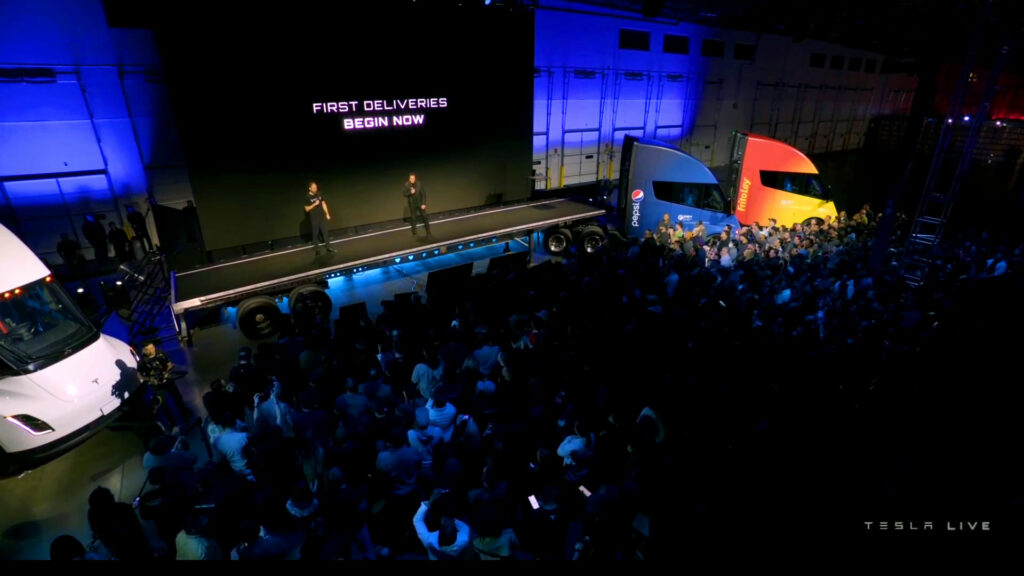Tesla celebrated the delivery of its very first customer Semi trucks during a fairly low-key event in Nevada last night. In addition to confirming details about the electric truck, the automaker also revealed a few other interesting tidbits about the Cybertruck and megawatt charging.
The main focus of the event was, of course, the Semi, whose first deliveries will be to PepsiCo and Frito-Lay. Tesla reaffirmed that the transport truck will be capable of going 500 miles (805 km) on a single charge and of driving at a total loaded weight of 82,000 pounds (37,194 kg), which is 2,000 pounds (907 kg) more than is allowed under U.S. federal regulations because it’s electric.
The automaker boasted about the truck’s abilities, with a chart showing its progress as it drove (tipping the scales at 81,000 pounds/36,740 kg) from Fremont to San Diego, California. The route saw the truck drive up 4,136 feet (1,261 meter) of elevation, and then back down again.
Read: Tesla Semi Completed A 500-Mile Trip With A Loaded Weight Of 81,000 pounds
Completed at highway speed, without charging on the way & over 4,000 ft of elevation https://t.co/nZomwI7DbY pic.twitter.com/9MB0ejk2o6
— Tesla (@Tesla) December 2, 2022
Helping it on the final leg of the trip were the regenerative brakes that use the vehicle’s motion to recharge the batteries. Tesla’s senior manager for truck engineering, Dan Priestly, said that this function may actually be a safety benefit because drivers won’t have to downshift, and may not have to even touch the brakes as they descend hills. Might be nice for people who live by the highway, too.
Megawatt charging system.
Although the regenerative braking will help get the truck farther, it will still need to charge big batteries when it runs out of juice. To do that, Tesla revealed more about its “megawatt” charging system.
The technology is important for bigger applications like the Semi, according to Priestly, and requires some very technical engineering to do safely. According to the executive, though, a water-cooling system in the charger will allow the cable that delivers the power to remain small and maneuverable.
“You’re actually immersing the conductor in the coolant—this water-based coolant that we have, and we’re done doing some really neat isolation monitoring on the back end to ensure that it’s safe and delivering what it needs to,” said Priestly. “But it means that we can really shove a lot of current in a very, very small place. So, you know, for those that have charged their cars at a V3 Supercharger and the cable’s nice and maneuverable, it’s the same thing here, but now we’re just shoving a megawatt through it, instead.”
That small size means that, not only will megawatt charging be available at truck stops, it will also be available at regular Superchargers. And that will be useful, because according to CEO Elon Musk, the Cybertruck will be capable of charging at megawatt speeds.
Tesla engineers tested Semi in a variety of harsh conditions to maximize reliability & durability pic.twitter.com/qjctWZSWvQ
— Tesla (@Tesla) December 2, 2022
Just how long the chargers will take to fill the battery in the Cybertruck or, indeed, the Semi, has not been revealed. The execs did say, though, that the latter’s tri-motor, 1,000-volt powertrain will make its way into other vehicles in the Tesla lineup, though it stopped short of saying which ones.
That’s just one of the pieces of information that was not revealed at this event. In addition, Tesla did not reveal how much the Semi will cost, nor how many it is capable of producing.








